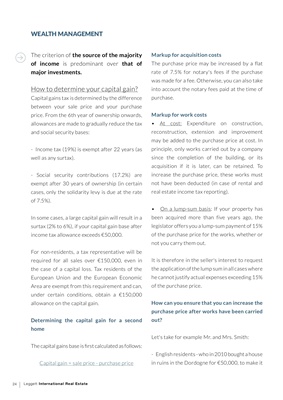
24 Leggett International Real Estate
The criterion of the source of the majority
of income is predominant over that of
major investments.
How to determine your capital gain?
Capital gains tax is determined by the difference
between your sale price and your purchase
price. From the 6th year of ownership onwards,
allowances are made to gradually reduce the tax
and social security bases:
- Income tax (19%) is exempt after 22 years (as
well as any surtax).
- Social security contributions (17.2%) are
exempt after 30 years of ownership (in certain
cases, only the solidarity levy is due at the rate
of 7.5%).
In some cases, a large capital gain will result in a
surtax (2% to 6%), if your capital gain base after
income tax allowance exceeds €50,000.
For non-residents, a tax representative will be
required for all sales over €150,000, even in
the case of a capital loss. Tax residents of the
European Union and the European Economic
Area are exempt from this requirement and can,
under certain conditions, obtain a €150,000
allowance on the capital gain.
Determining the capital gain for a second
home
The capital gains base is first calculated as follows:
Capital gain = sale price - purchase price
Markup for acquisition costs
The purchase price may be increased by a flat
rate of 7.5% for notary's fees if the purchase
was made for a fee. Otherwise, you can also take
into account the notary fees paid at the time of
purchase.
Markup for work costs
• At cost: Expenditure on construction,
reconstruction, extension and improvement
may be added to the purchase price at cost. In
principle, only works carried out by a company
since the completion of the building, or its
acquisition if it is later, can be retained. To
increase the purchase price, these works must
not have been deducted (in case of rental and
real estate income tax reporting).
• On a lump-sum basis: If your property has
been acquired more than five years ago, the
legislator offers you a lump-sum payment of 15%
of the purchase price for the works, whether or
not you carry them out.
It is therefore in the seller's interest to request
the application of the lump sum in all cases where
he cannot justify actual expenses exceeding 15%
of the purchase price.
How can you ensure that you can increase the
purchase price after works have been carried
out?
Let's take for example Mr. and Mrs. Smith:
- English residents - who in 2010 bought a house
in ruins in the Dordogne for €50,000, to make it
WEALTH MANAGEMENT